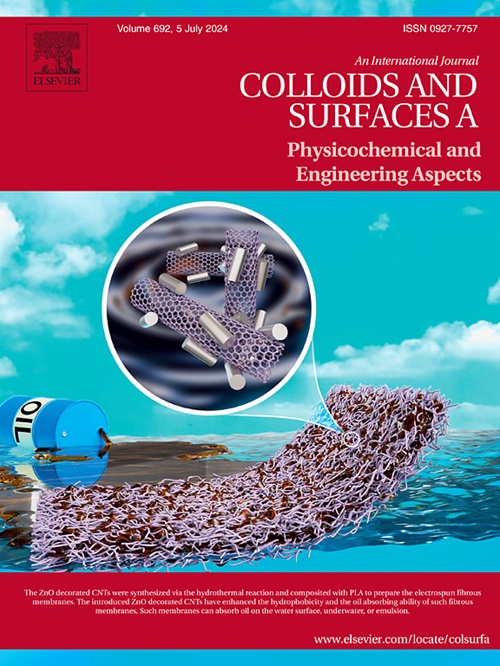Modulating electronic structure with sulfur doping to enhance hydrogen coverage and accelerate hydrogen evolution reaction
IF 4.9
2区 化学
Q2 CHEMISTRY, PHYSICAL
Colloids and Surfaces A: Physicochemical and Engineering Aspects
Pub Date : 2025-04-18
DOI:10.1016/j.colsurfa.2025.136980
引用次数: 0
Abstract
Optimizing the surface electronic structure of catalysts is crucial for enhancing the kinetics of the hydrogen evolution reaction (HER). Herein, We have successfully fabricated sulfur (S)-doped nickel hydroxide loaded iridium-rhodium alloy heterojunction catalysts (RhIr/S-Ni(OH)2/NF). The introduction of the highly electronegative element S into the Ni(OH)2 lattice can modulate the electronic structure of the catalyst surface, thus keeping the RhIr alloy in an electron-rich state. In this state, water dissociation occurs on the S-Ni(OH)2, while hydrogen adsorption and desorption take place on the RhIr active sites. Such modification significantly improves the hydrogen adsorption free energy while promoting efficient desorption kinetics, leading to superior catalytic activity of RhIr/S-Ni(OH)2/NF. The prepared RhIr/S-Ni(OH)2/NF catalyst possesses outstanding performance for HER, with overpotentials of just 9 mV and 125 mV at the current density of 10 and 100 mA cm−2, respectively, and it sustains working at 500 mA cm−2 for 400 hours. This research presents a novel electronic regulation strategy and provides valuable insights for the development of advanced electrocatalysts.
用硫掺杂调制电子结构,提高氢覆盖,加速析氢反应
优化催化剂的表面电子结构是提高析氢反应动力学的关键。本文成功制备了硫(S)掺杂氢氧化镍负载铱铑合金异质结催化剂(RhIr/S- ni (OH)2/NF)。在Ni(OH)2晶格中引入高电负性元素S可以调节催化剂表面的电子结构,从而使rir合金保持富电子状态。在此状态下,水在S-Ni(OH)2上发生解离,而氢的吸附和解吸发生在RhIr活性位点上。这种改性显著提高了氢的吸附自由能,同时促进了高效的脱附动力学,使得RhIr/S-Ni(OH)2/NF具有优异的催化活性。所制备的RhIr/S-Ni(OH)2/NF催化剂具有优异的HER性能,在电流密度为10和100 mA cm−2时,过电位分别为9 mV和125 mV,并能在500 mA cm−2下持续工作400 小时。本研究提出了一种新的电子调控策略,为先进电催化剂的开发提供了有价值的见解。
本文章由计算机程序翻译,如有差异,请以英文原文为准。
求助全文
约1分钟内获得全文
求助全文
来源期刊
CiteScore
8.70
自引率
9.60%
发文量
2421
审稿时长
56 days
期刊介绍:
Colloids and Surfaces A: Physicochemical and Engineering Aspects is an international journal devoted to the science underlying applications of colloids and interfacial phenomena.
The journal aims at publishing high quality research papers featuring new materials or new insights into the role of colloid and interface science in (for example) food, energy, minerals processing, pharmaceuticals or the environment.

 求助内容:
求助内容: 应助结果提醒方式:
应助结果提醒方式:


